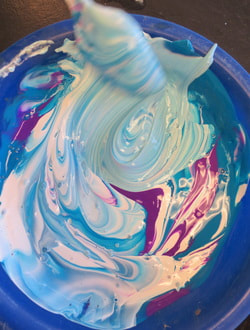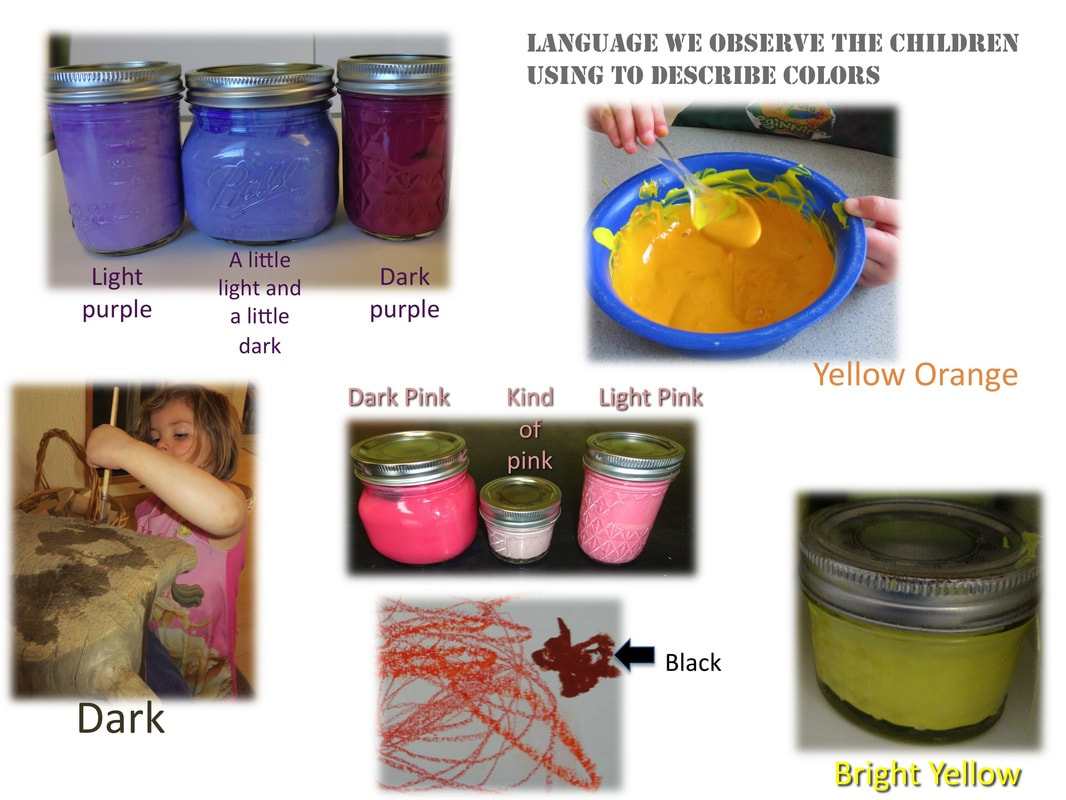What language do we use with the children around the process of creating colors of paint? What words are they using to describe different colors? How can we help expand this language?
To "mix" or not to "mix" - that is the question
Reflecting upon the language we are using with the children
Reflecting upon the language we are using with the children

This question caused us to reflect heavily on the language we use with children during these experiences and whether this language was the most appropriate. Further, how did the language we use influence the children's intentions during the experience? We noted that we used the word "mix" most frequently to provide a context for these experiences - we would invite the children to "mix" paints. What does it mean to "mix" and did the word "mix" capture the complexity of the process of color transformation?
Oxford dictionary defines MIX - combine or put together to form one substance or mass; make or prepare by combining various ingredients
Oxford dictionary defines COMBINE - unite, merge
Oxford dictionary defines MERGE - combine or cause to combine to form a single entity
After reviewing the definition for "mix" as well as other related words, we decided that this word was not the most appropriate to describe the process of color transformation. Upon further reflection, "mixing" seemed to imply simply an action - to "mix" colors - whereas what was taking place inside their bowl was much more than that. Furthermore, the word "mix" unintentionally reinforced the means-to-an-end goal of creating new jars of paint - our language to describe our work with children reflects our actions during the experience and by using the word "mix" we were simply going in to "mix" colors together to create new colors for the jars. Finally, the word did not express any qualities of scientific process or inquiry that could potentially exist during these experiences of watching colors merge together and dramatically transform in front of your eyes. We decided to substitute the word "create" for "mix" in the mean time until we discover a more appropriate word.
Oxford dictionary defines CREATE - bring (something) into existence.....interestingly, this word does not seem to capture the complexity and the scientific qualities of the experience either
We have noted that the children often use the words "change" and "turn" to describe what is taking place with the colors inside their bowls...
Oxford dictionary defines CHANGE - make or become a different substance entirely; transform (Oxford dictionary defines TRANSFORM - makes thorough or dramatic change in the form, appearance, or character of)
Oxford dictionary defines TURN - change in nature, state, form, or color; become
These words seem much more appropriate! How might we begin to use this language as the common language with the children to describe the process?
Oxford dictionary defines MIX - combine or put together to form one substance or mass; make or prepare by combining various ingredients
Oxford dictionary defines COMBINE - unite, merge
Oxford dictionary defines MERGE - combine or cause to combine to form a single entity
After reviewing the definition for "mix" as well as other related words, we decided that this word was not the most appropriate to describe the process of color transformation. Upon further reflection, "mixing" seemed to imply simply an action - to "mix" colors - whereas what was taking place inside their bowl was much more than that. Furthermore, the word "mix" unintentionally reinforced the means-to-an-end goal of creating new jars of paint - our language to describe our work with children reflects our actions during the experience and by using the word "mix" we were simply going in to "mix" colors together to create new colors for the jars. Finally, the word did not express any qualities of scientific process or inquiry that could potentially exist during these experiences of watching colors merge together and dramatically transform in front of your eyes. We decided to substitute the word "create" for "mix" in the mean time until we discover a more appropriate word.
Oxford dictionary defines CREATE - bring (something) into existence.....interestingly, this word does not seem to capture the complexity and the scientific qualities of the experience either
We have noted that the children often use the words "change" and "turn" to describe what is taking place with the colors inside their bowls...
Oxford dictionary defines CHANGE - make or become a different substance entirely; transform (Oxford dictionary defines TRANSFORM - makes thorough or dramatic change in the form, appearance, or character of)
Oxford dictionary defines TURN - change in nature, state, form, or color; become
These words seem much more appropriate! How might we begin to use this language as the common language with the children to describe the process?
Color defined through the languages of light and mathematics
Reflecting upon the language used by the children
Reflecting upon the language used by the children
Overall, we have observed the children using the mathematical language for expressing quantity ("a little") and language associated with describing the presence of light ("dark," "light," and "bright") to discriminate among the subtle differences of each color. Interestingly, both mathematics and light have a huge influence on the appearance of color. In regard to mathematics, certain formulas produce certain colors and the slightest addition or subtraction of any aspect of each formula can have a dramatic influence on the final state of the color. In regard to light, color exists only through the presence of light. In the absence of light, color is absent as well. The slightest modification in light can also have a dramatic impact on the appearance of a color. We are curious how the children will continue to expand upon this language as a tool for describing colors. In the meantime, how might we become more informed on the possibilities of these two different languages? What words might we expect them to use in the future? How might opportunities to play with various levels of light and darkness influence this language?
You will notice above that a child referred to a dark red as "black." We believe that in this situation the child was using the word "black" as a way to express "the darkest color" rather than expressing the actual color of black. This was a reminder to us that our initial interpretation of what children share with us may not always be correct - for example, we may have initially concluded that Foster does not know "black" - and why it is critical that we deeply examine the possible meanings behind what they are sharing so that we can develop shared understandings with the children.
We also wonder when and how it is appropriate to introduce names for colors that they may yet be aware of, such as turquoise, lavender, maroon, and magenta. Are there experts that already exist within the group that could be catalysts for introducing these new names for color? We hope to continue to offer many opportunities for the children to be exposed to color - you have to be exposed to color in order to describe and break down color.
You will notice above that a child referred to a dark red as "black." We believe that in this situation the child was using the word "black" as a way to express "the darkest color" rather than expressing the actual color of black. This was a reminder to us that our initial interpretation of what children share with us may not always be correct - for example, we may have initially concluded that Foster does not know "black" - and why it is critical that we deeply examine the possible meanings behind what they are sharing so that we can develop shared understandings with the children.
We also wonder when and how it is appropriate to introduce names for colors that they may yet be aware of, such as turquoise, lavender, maroon, and magenta. Are there experts that already exist within the group that could be catalysts for introducing these new names for color? We hope to continue to offer many opportunities for the children to be exposed to color - you have to be exposed to color in order to describe and break down color.
"Families" of color
During the process of organizing the different shades into families there were a few occasions when children had different perspectives about which family a particular color belonged. The situation was quickly resolved by the child holding the jar placing the jar with the family s/he believed to be most appropriate. We wonder how we can better turn these situations into opportunities for the children to share their perspectives, debate their ideas, and create shared understandings.
Meaningful inquiry
As we continue to work with the children and find opportunities for them to express and expand upon their language we are continually assessing the level of relevance and arbitrariness of the types of questions we are asking and comments we are making. We wonder...
What are meaningful ways to invite children to offer names for the different colors they produce?
We are experimenting with different ways of asking this question so it does not come off as rhetorical or agenda-driven, where we already have the right answer and just want to make sure children know. One shift involves asking “What color do you see?” rather than “What color is this?”. We also believe that offering a variety of opportunities for children to naturally encounter color will create authentic occasions for describing colors on their own.
We are also struggling with meaningful and relevant ways of provoking the children to verbalize what they notice as the subtle differences in colors and getting at their understandings of these differences. Often we will ask, "What is different?" before the children have indicated to us that they notice a difference. Again, one strategy we have used to gather this information has been to offer variety of opportunities for children to naturally encounter color so that authentic occasions emerge for describing the differences among colors.
What are meaningful ways to invite children to offer names for the different colors they produce?
We are experimenting with different ways of asking this question so it does not come off as rhetorical or agenda-driven, where we already have the right answer and just want to make sure children know. One shift involves asking “What color do you see?” rather than “What color is this?”. We also believe that offering a variety of opportunities for children to naturally encounter color will create authentic occasions for describing colors on their own.
We are also struggling with meaningful and relevant ways of provoking the children to verbalize what they notice as the subtle differences in colors and getting at their understandings of these differences. Often we will ask, "What is different?" before the children have indicated to us that they notice a difference. Again, one strategy we have used to gather this information has been to offer variety of opportunities for children to naturally encounter color so that authentic occasions emerge for describing the differences among colors.



